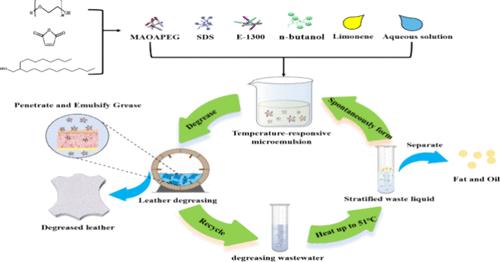Temperature-Responsive Microemulsion for Efficient Recyclable Degreasing of Fatty Pickled Sheepskin
IF 3.9
2区 化学
Q2 CHEMISTRY, MULTIDISCIPLINARY
引用次数: 0
Abstract
In the leather production process, emulsification degreasing can effectively remove grease. However, the direct discharge of emulsifiers often leads to substantial pollution. With the aim of addressing this issue and realizing the recycling of degreasing agents, temperature-responsive microemulsions were proposed for the leather degreasing process in this research. First, a series of polyether surfactants (MAOAPEG-m, mm = 600, 800, 2000, 4000) were designed and synthesized. Subsequently, the temperature-responsive microemulsion system was constructed with MAOAPEG-m, SDS, E-1300 (isotridecyl alcohol polyoxyethylene ether), n-butanol, D-limonene, and NaCl. Then, the influence of the polyether segment length on the microemulsion region, conductivity, droplet size, and absorbance was systematically investigated. Finally, the microemulsion was applied in the degreasing experiment of fatty pickled sheepskin. The results showed that the degreasing rate of the microemulsion could reach 76.7%, which was higher than that of the commercial degreasing agent. Furthermore, after five cycles, the degreasing rate of the microemulsion still remained above 60%. These results indicated that the microemulsion had superior performance in leather degreasing and oil separation, thereby providing an effective method for the recyclable degreasing process of leather.

温度响应型微乳液用于高效可回收的酸洗羊皮脱脂
在皮革生产过程中,乳化脱脂能有效去除油脂。然而,乳化剂的直接排放往往会导致严重的污染。为了解决这一问题,实现脱脂剂的循环利用,本研究提出了温度响应型微乳液用于皮革脱脂工艺。首先,设计并合成了一系列聚醚表面活性剂(MAOAPEG-m, mm = 600, 800, 2000, 4000)。随后,用MAOAPEG-m、SDS、E-1300(异三十六醇聚氧乙烯醚)、正丁醇、d -柠檬烯和NaCl构建温度响应微乳液体系。然后,系统地研究了聚醚段长度对微乳液区域、电导率、液滴尺寸和吸光度的影响。最后,将微乳剂应用于油脂腌羊皮的脱脂实验。结果表明,该微乳液的脱脂率可达76.7%,高于工业脱脂剂的脱脂率。经过5次循环后,微乳液的脱脂率仍保持在60%以上。结果表明,该微乳液具有优异的皮革脱脂和油脂分离性能,为皮革的可循环脱脂工艺提供了一种有效的方法。
本文章由计算机程序翻译,如有差异,请以英文原文为准。
求助全文
约1分钟内获得全文
求助全文
来源期刊

Langmuir
化学-材料科学:综合
CiteScore
6.50
自引率
10.30%
发文量
1464
审稿时长
2.1 months
期刊介绍:
Langmuir is an interdisciplinary journal publishing articles in the following subject categories:
Colloids: surfactants and self-assembly, dispersions, emulsions, foams
Interfaces: adsorption, reactions, films, forces
Biological Interfaces: biocolloids, biomolecular and biomimetic materials
Materials: nano- and mesostructured materials, polymers, gels, liquid crystals
Electrochemistry: interfacial charge transfer, charge transport, electrocatalysis, electrokinetic phenomena, bioelectrochemistry
Devices and Applications: sensors, fluidics, patterning, catalysis, photonic crystals
However, when high-impact, original work is submitted that does not fit within the above categories, decisions to accept or decline such papers will be based on one criteria: What Would Irving Do?
Langmuir ranks #2 in citations out of 136 journals in the category of Physical Chemistry with 113,157 total citations. The journal received an Impact Factor of 4.384*.
This journal is also indexed in the categories of Materials Science (ranked #1) and Multidisciplinary Chemistry (ranked #5).
 求助内容:
求助内容: 应助结果提醒方式:
应助结果提醒方式:


